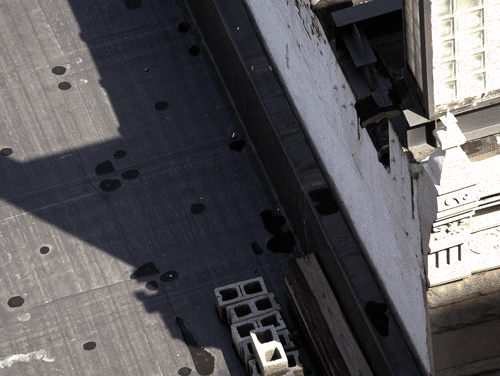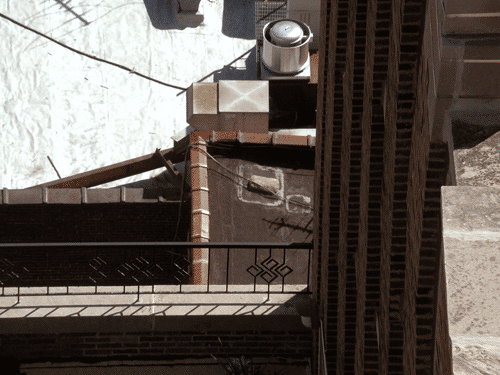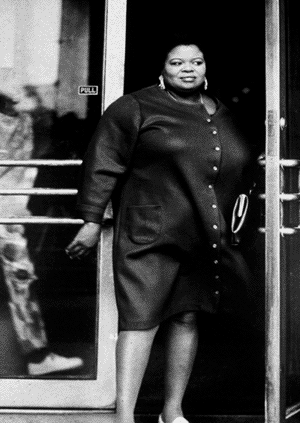
Entangled
By the View
John B Rohrbach
These photographs unnerve me. Their overlay of facades and rooftops seem
so recognizable exactly what I would expect to see from the upper reaches
of an office building or apartment tower in any number of American cities.
Their subtle color further enhances their familiarity and realism. Even
their complex layering of form speaks succinctly of urban dynamism. I
feel privileged to be so high up. Yet I can not get my bearings. Knowing
Barbara Crane=s longstanding commitment to photographing Chicago=s Loop
delivers intellectual bearing. She took these photographs from the roofs
of downtown parking garages. But I feel like I am floating in a void before
a fluctuating jigsaw puzzle rather than securely embedded within a neighborhood.
Only upon determined reflection do I recognize these dizzying Loop photographs to be emblems rather than landscapes. In true modernist fashion, they defiantly project a purely camera-determined order. Offering eloquent constructions of equally animated detail, they vacillate between flatness and depth. Their array of compressors, vents, rooflines, and walls present acutely balanced triangles, rectangles, circles, and squares that evoke cubist, even suprematist imaginings. (Crane still builds on her Bauhaus roots.) Their deep shadows, though merely reflecting sunlight-shaped happenstance, suggest the black gestural imaginings of Motherwell and Kline. Fluidly blending the concrete with the abstract, these pictures personalize the world.
Just as pungent is their emptiness. Virtually devoid of people, commerce, or even the ubiquitous fast food wrapper, the images exude a palatable quiet and an antiseptic cleanliness that sucks me graciously into their coolly alluring abstract beauty only to repel me back out with a driving, radiating energy. Rather than evoke the romantic loftiness of an earlier age they defiantly project a tangle of equally competing forces. Instead of the usual repeating lines of steel and glass comfortably tugging one beyond the seen, they proffer an explosive tension that is bound tightly within the frame. These photographs are self-sufficient tales rather than fragments of a larger whole. They reject any notion of a straight-line narrative, replacing it with a layered web defined by space rather than time. I can not let go.

Forward:
Perceptual Adventures
Michael A Weinstein
Throughout her distinguished career as a photographic artist, Barbara
Crane has been a ceaseless adventurer, exploring new dimensions ofvision
with a scrupulous attention to technical discipline and a deep feeling
for her widely diverse subjects, which she loving transforms through her
rigorous straight practice.
Crane has been equally adept as a street photographer, capturing significant
gesture and expression, and as a meditative photographer,
grasping the stillness of the still in a Zenlike way that reveals new
possibilities for the natural or cultural subject in its distinct singularity.
She has united her two sides through a persistent disposition to see into
the particularity of things and to bring their uniqueness forth through
the camera.
Although she is a “straight” photographer, Crane is not a realist
who believes who believes that the lens is a window on the world; acutely
reflective
about her art, she realizes that the photograph presents visions of aspects
of the world that are formed by techniques and media that
transform subjects into images that are inaccessible to ordinary perception.
Crane works with the understanding that each set of techniques and media
that she deploys will yield a different way of seeing; her aim is to make
diverse ways of seeing as impactful and precise as possible.
For Crane, we see things as they are for the camera.
In her series on roof tops and facades, shot from the upper tiers of Chicago
parking garages, Crane remains true to her experimental impulse. She is
using new equipment and media (a digital camera and digital printing)
and is working in color. Her subject is also fresh; although she has engaged
with the city's architecture before, Crane's
black-and-white "Chicago Loop Series, 1976-1978" was formal
and orderly, whereas
now she is drawn to chaos. Crane has also set herself a new and demanding
problem - making the still photograph come dynamically to life.
From her vantage point in the parking garage, Crane looks out over the
city and sees a jumble of shapes and forms that result from "the
inevitable disorder produced by urban growth." What can photographic
vision do to render this chaos vivid and vitalizing, teeming with energy?
Crane's strategy is to shoot her roof tops and facades through a telephoto
lens, which flattens her subjects, compacting them, compressing and accentuating
their angularity and altering our perception of their depth. The resulting
images are involving and intriguing plays of vision in which our eyes
are continually thwarted from seizing upon a stable subject as elements
in the background pop into the foreground and then recede, and we jump
from one visual punctum and detail to the next.
Although it bears resemblance to cubist, Gestalt and op-art imagery, Crane's
photography opens up its own domain of vision. Her roof tops and facades
have been abstracted by the camera, yet the images are not abstractions;
we never lose sight of what we are looking into, but we see the city as
we have never seen it before, as a marvellously colorful dance of still
and solid structures that we could never glimpse with the naked eye.
Barbara Crane's return to the city is a landmark achievement for transformative
photographic vision. She has made urban chaos come alive as a trip through
a space exploding with the most powerful pleasant surprises.

